Ginger Pickled Carrots
I have three words for you… ginger pickled carrots! If your farmer’s market is flooded with gorgeous locally grown carrots right now like mine is then you have to try this delicious recipe! And if not, you still need to try this recipe. Yes, it’s that good.

This post contains affiliate links
Table of contents
Why You’ll Want To Make Ginger Pickled Carrots
I have a confession. Canning intimidates me a little. So when Katie asked if I was interested in reviewing Rebecca’s cookbook, Not Your Mama’s Canning Book, I said, “suuuuure,” while covertly nodding my head noooooo.
The canning process is always a little scary for me but I decided to face my fears, jump in and make these ginger pickled carrots.
It was hard to choose a recipe to start with, but I was drawn to the ginger pickled carrots. Maybe because I had just bought a ton of carrots at the farmer’s market, but then I started thinking that they may be good on a charcuterie board or to top off Chicken Lettuce Wraps or in a homemade Banh Mi, and then I couldn’t start making these pickled carrots fast enough.
If you are a seasoned pro at canning then you’ll definitely want to first pick up a copy of this book, next make these carrots that we have today, and lastly, you should also check out our new recipe for simple Rhubarb Compote with Ginger and Cardamom. It’s another great recipe that can be canned!
Ultimately I realized that the process was familiar, pretty simple and with Rebecca’s awesome instructions not too scary. Just boil the vinegar, ginger, star anise, a few other seasonings and sugar until the sugar melts.
Then simmer the carrots in the brine for a quick 2 minutes and you’re off to the canning races! Afterwards, I was the proud owner of three gorgeous pints of bright orange pickled deliciousness!
So if you are on the fence, let me tell you, these carrots are worth getting over your canning fears and they can be used in a wide variety of recipes. Or you can eat them straight out of the jar because they are that good!
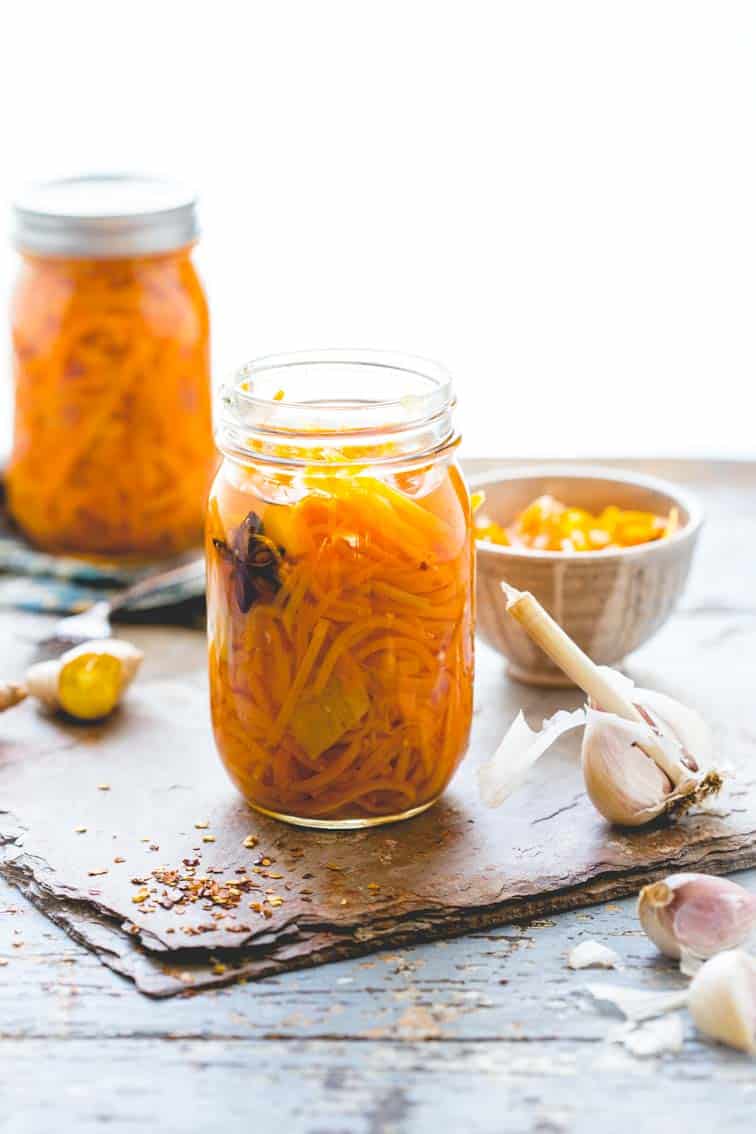
Ingredient Notes
Carrots
You will need 2 pounds of carrots that have been peeled. From there, get out your mandoline or cut by hand into 1/4-inch thick by 3-inch long matchsticks. We do not recommend buying pre-cut carrots as they do not have enough flavor.
Rice Wine Vinegar
For the acid in the brine, we use rice wine vinegar which is moderately acidic. Do not use seasoned rice wine vinegar as that has added sugar and sodium in it.
Seasonings
- fresh ginger root
- star anise
- granulated sugar
- crushed red pepper flakes
- garlic, peeled and minced
- kosher salt
How To Pickle Carrots
Step 1: Cut Carrots
Use a julienne blade on a mandoline or a vegetable peeler to cut the carrots into ¼-inch (6-mm) matchstick pieces about 3 inches (7.6 cm) in length.
Step 2: Make Brine
In a stainless steel or other non-reactive pot, combine the vinegar, water, ginger, star anise, sugar, crushed red pepper flakes, garlic and salt. Bring to a boil, stirring just until the sugar is dissolved. Use a slotted spoon to remove the star anise from the boiling brine and divide them evenly between the jars.
Step 3: Cook Carrots In Brine and Place in Jars
Add the carrot sticks to the boiling brine. Bring the liquid back to a boil, about 2 minutes. Turn off the heat. Immediately use tongs or a slotted spoon to divide the carrot sticks between the jars, also putting 3 strips of ginger in each jar, packing if necessary to fit them all in, leaving ½ inch (13 mm) of headspace. Use a ladle to pour the hot brine over the carrot sticks, being sure to cover them.
Step 4: Prep Jars For Processing
Insert a sterile chopstick or knife into the jars to release air bubbles and add more brine if necessary to maintain the ½ inch (13 mm) headspace. Moisten a paper towel with vinegar and wipe the rims of the jars. Center a lid over each jar and screw on the rings to fingertip tightness or fix the clamps in place.
Step 5: Process Jars of Carrots
Place the jars in a boiling water canner filled with boiling water to cover the jars by 2 inches (5 cm). Bring to a full rolling boil and process for 10 minutes. Using canning tongs, carefully transfer the jars to a cooling rack or towel-lined counter to cool, undisturbed for 24 hours.
Step 6: Store
Wipe down the jars, remove the rings, and label them before storing them in a cool, dark place for up to a year.

Expert Tips for Canning Carrots and Other Vegetables
If this is your first time canning vegetables, welcome to the club! Don’t fret if you’re a little nervous to try canning for the first time, I was too. To make sure these pickled carrots turn out perfectly every time, there are a few things you need to keep in mind.
1. Don’t use chipped jars—chipped or cracked jars might introduce bacteria into your canned goods, which isn’t good for you! Plus, chipped jars might lead to leakages.
2. Sterilize your jars before canning—sterilizing your canning equipment before making these ginger pickled carrots is crucial. Again, you don’t want any bacteria or mold spores making their way into your canned goods. Use stainless-steel appliances if possible, and thoroughly clean the glass jars before starting the canning process.
3. Get rid of air bubbles—you can dislodge any air bubbles in the jars by inserting a knife or sterile chopstick into each and wiggling it around.
4. Boil the jars for roughly 10 minutes—when canning vegetables, do not try and take any shortcuts. The canned vegetables need lots of time and heat to properly kill all the bacteria and pickle properly. After you’ve boiled the pickled carrots for 10 minutes, you’ll need to let them rest on a towel for 24 hours.
5. Check for an indentation in the lid—after these ginger pickled carrots have rested on the countertop for 24 hours, check to make sure there’s an indentation in the lid. This will indicate whether or not the jars sealed properly.
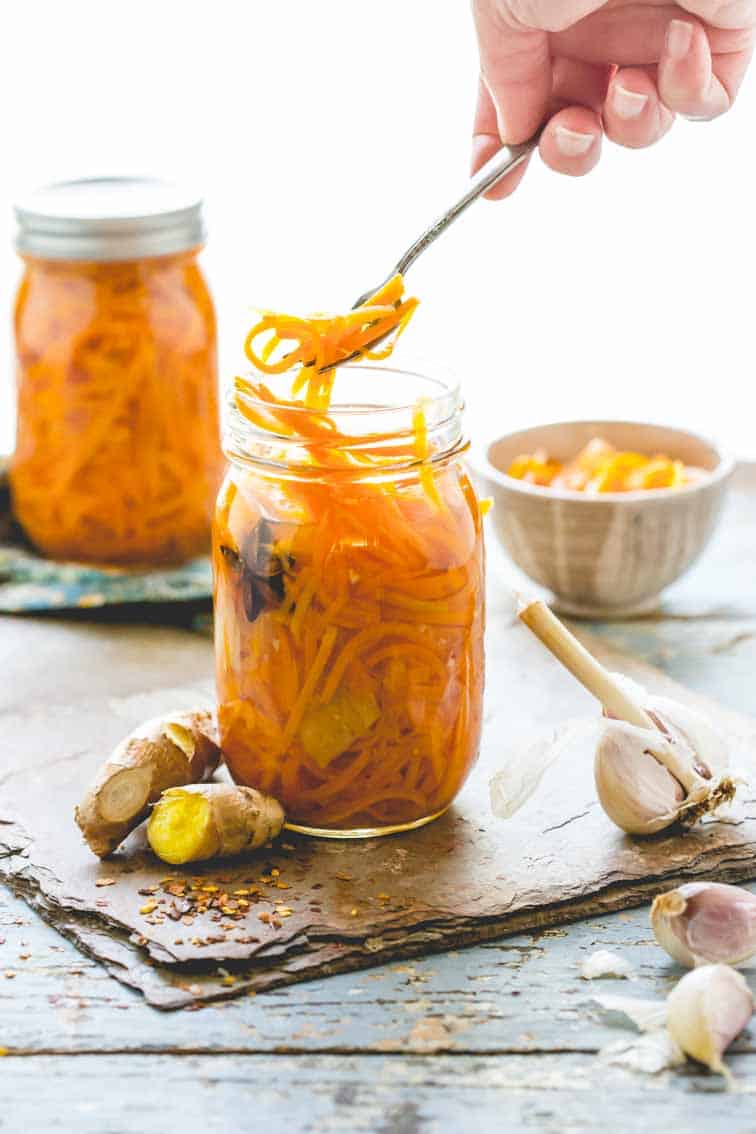
More Pickling, Sauces, and Condiment Recipes to Try
- Pickled Beets are a favorite summertime side dish to make.
- Maple Pickled Onions are a great topper for burgers and to add to cheese boards.
- This recipe for Roasted Delicata Squash Salad with Warm Pickled Onion Dressing is an outside-the-box recipe.
- This Basil Pesto is a great way to preserve the basil harvest. Store jars of it in the freezer all winter long.
- This Peach Maple Barbecue Sauce is finger-licking good!
Carrot Recipe Love
- If you are a big fan of carrots try this recipe for Mashed Carrots and Parsnips.
- This Roasted Carrots and Onions recipe is great for meal prep.
- Our Roasted Baby Carrots are an easy side for a holiday meal or a weeknight dinner.
- These Maple Glazed Carrots are sweet and savory and not syrupy like some recipes.
- Our recipe for Carrot Salad with Lemony Dressing is a burst of bright flavor.
- This Carrot Ginger Soup with Oregano Croutons is clean eating at its best.
- Have you tried this recipe for Maple Carrot Cake with Cream Cheese Frosting yet? It’s one of our all time favorite desserts.
- These recipes for Carrot Cake Waffles or Morning Glory Muffins are two ways to get in your carrots at breakfast!
Thanks so much for reading! If you are new here, you may want to sign up for my email newsletter to get a free weekly menu plan and the latest recipes right to your inbox. If you make this recipe, please come back and leave a star rating and review. I would love to hear what you thought!
Happy Cooking! ~Katie
Print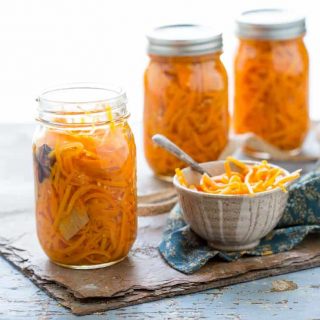
Ginger Pickled Carrots Recipe
- Total Time: 25 minutes
- Yield: 3 pints 1x
Description
I have three words for you… ginger pickled carrots! If your farmer’s market is flooded with gorgeous locally grown carrots right now like mine is this Fall then you have to try this delicious vegetarian canning recipe!
Ingredients
- 2 pounds (908 g) of peeled carrots
- 2 cups (475 ml) unseasoned rice wine vinegar
- 1 1/2 cups (350 ml) water
- 9 long strips (about 3- to 4-inch [7.6- to 10-cm] each) of peeled, fresh ginger root
- 3 whole star anise
- 3/4 cup (144 g) raw or granulated sugar
- 1 tbsp (5 g) crushed red pepper flakes
- 1 clove garlic, peeled and minced
- 1 tsp kosher salt
Instructions
- Use a julienne blade on a mandoline or a vegetable peeler to cut the carrots into ¼-inch (6-mm) matchstick pieces about 3 inches (7.6 cm) in length.
- In a stainless steel or other non-reactive pot, combine the vinegar, water, ginger, star anise, sugar, crushed red pepper flakes, garlic and salt. Bring to a boil, stirring just until the sugar is dissolved. Use a slotted spoon to remove the star anise from the boiling brine and divide them evenly between the jars.
- Add the carrot sticks to the boiling brine. Bring the liquid back to a boil, about 2 minutes. Turn off the heat. Immediately use tongs or a slotted spoon to divide the carrot sticks between the jars, also putting 3 strips of ginger in each jar, packing if necessary to fit them all in, leaving ½ inch (13 mm) of headspace. Use a ladle to pour the hot brine over the carrot sticks, being sure to cover them.
- Insert a sterile chopstick or knife into the jars to release air bubbles and add more brine if necessary to maintain the ½ inch (13 mm) headspace. Moisten a paper towel with vinegar and wipe the rims of the jars. Center a lid over each jar and screw on the rings to fingertip tightness or fix the clamps in place.
- Place the jars in a boiling water canner filled with boiling water to cover the jars by 2 inches (5 cm). Bring to a full rolling boil and process for 10 minutes. Using canning tongs, carefully transfer the jars to a cooling rack or towel-lined counter to cool, undisturbed for 24 hours.
- Wipe down the jars, remove the rings and label before storing in a cool, dark place for up to a year.
Notes
Be sure to use unseasoned rice vinegar rather than seasoned rice vinegar. Seasoned rice vinegar has sugar and salt added already. We prefer to control the amount and type of sugar and salt we add to our carrots.
- Prep Time: 25 minutes
- Category: Snack
- Method: Canning
- Cuisine: American
Nutrition
- Calories: 54
- Sugar: 8 g
- Sodium: 76 mg
- Fat: 0 g
- Saturated Fat: 0 g
- Carbohydrates: 10 g
- Fiber: 1 g
- Protein: 1 g
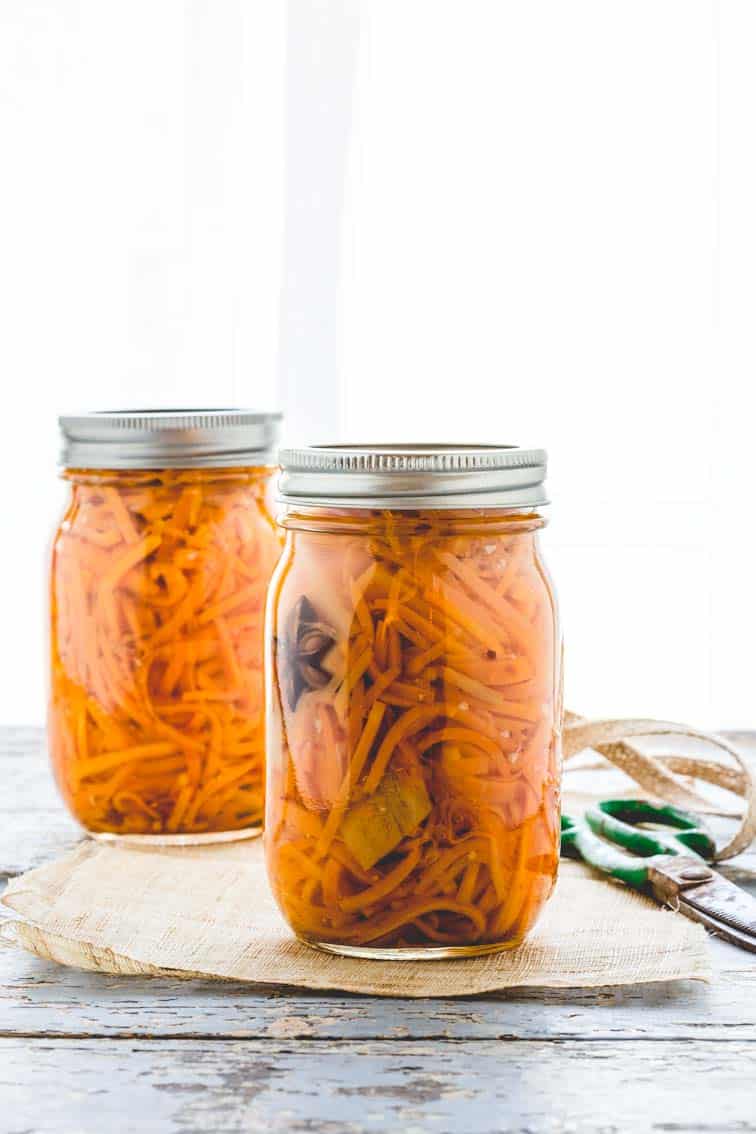

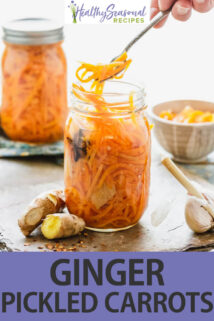


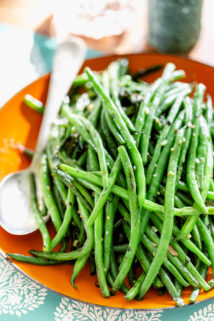
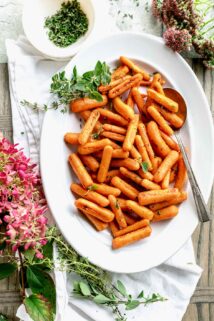
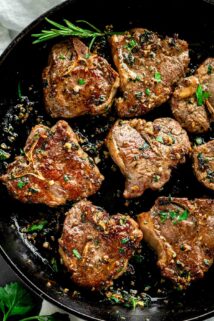
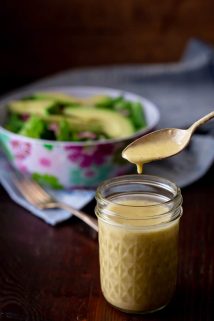

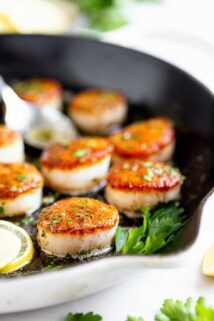
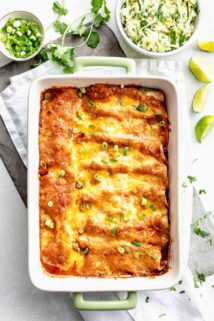


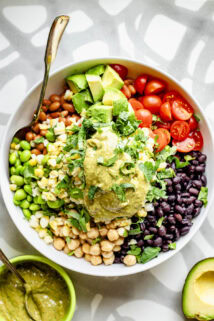
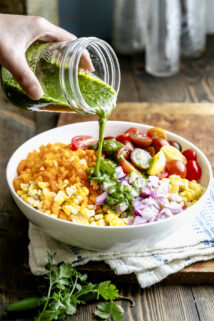
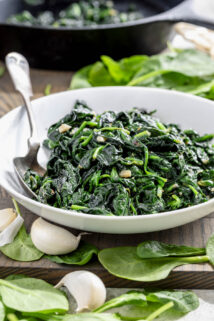
This is my favourite go to recipe. Great on an hor’douvers plate, as a salad or my secret ingredient in all my stir fries, including the preserving syrup (no longer a secret )
Love that! Thank you Teresa!
I’ve not yet made these, but sure sound good. If I have a jar big enough to accommodate all of the carrots and plan to use them in the next two weeks, I need not worry about doing the whole process of boiling the filled, tightly capped jars, right? or wrong? I can just store the lot of them in the fridge..?
Can i store it in the cupboard and for how long? 🙂
I am new to canning but I’ve been told that carrots and all root vegetables need to be pressure canned so this recipe makes me wonder if it is safe?
I can’t find unseasoned rice vinegar. Can I still use the seasoned one?
No I would not it will be too sweet/salty. You can sub in white vinegar instead.
Is there a way to print the recipe without printing the add that takes up an entire page almost about something totally unrelated? Also, the add cut off part of the recipe. These are blog deal-breakers for me unfortunately. Looks like you have an awesome blog too!
Hey Tracy, When I go to print I do not get any ads so this is the first I am hearing of this. Thank you so much for bringing this to my attention! That is annoying! What browser are you using? Are you on mobile or desktop? I can take this information to my Ad network to trouble shoot.
Do you really add 1 TBSP of red pepper flakes for 3 pints of carrots? I’m not sure I could eat that… I made some tonight and added 1 tsp for 6 pints and when I tasted one later, it had pepper heat but not flaming hot heat. So curious if you really meant 1 Tbsp or 1 tsp???
I also grated my carrots (I have a chronic hand injury, couldn’t make carrot sticks) and this will be an amazing add to any salad. The brine I’m already thinking can be turned into salad dressing, marinade for meat, etc…
So you know what the processing time would be for quarts? I have 8 children, so pints don’t last long around here 😉
I’m looking forward to trying this recipe. In the UK we don’t really do canning so I’m really curious to try it. We have a stock of ball jars after my husband had a brief love affair with kimchi.
Do I need a special ‘canning’ pan or can I bring it to the boil in my normal pressure cooker or broiler? Once I decide to open my jar of carrots, how long will they last and do i need to refrigerate after opening?
Thanks
Hi Sam. I have used a large stock pot and it works okay. I now do have a canning pot and it helps a lot because there is a special rack that has handles that you can lower and raise in and out of the water. Without it you can do it just fine though. Once open they should last in the fridge for around a month (if you don’t eat them first!) The salt and vinegar help to preserve them well.
I’ve been wanting to make this recipe but my concern is with the rice vinegar. USDA recommends using vinegar with a 5% acidity and all the rice vinegars I find are diluted to 4.2%-4.3%. Does the ratios in this recipe account for that? I anxiously await your response.
Rebecca is all about food science so I trust her research on this one Patty. I can send her an email and double check though.
I think it’s fine because the vinegar to water ratio in this recipe uses less water than usual for water bath canned pickle recipes, to account for the less acidic rice vinegar, and make the acidity level of the finished brine acidic enough for safety standards.
getting ready to make this recipe and asking for a bit of clarification on the dimensions of the ginger. A strip about how thick? Like a strip taken off with a veggie peeler or…. Thanks in advance
Sorry I am just seeing this comment Joan. I am sure you figured it out already. But what Stephanie did with the batch she made was cut the root lengthwise into thin strips. I’d say they were thinner than a quarter inch. She used a knife.
I added these to a salad and they added such marvelous flavor and texture! SO good!
That sounds good. I put them on everything when I had them on hand! Lol!
Excellent! Try it on fish tacos or on a charcuterie board.
I love that idea! Pickled veggies on a charcuterie board is always such a welcome change of flavor.
I made these this past summer and MAN THIS IS THE BEST recipe EVER!! So much so that we are planting a TON of carrots this year in our garden just to make this delicious recipe. Hey, some days we even eat them as a vegetable side to our lunches 🙂
Thanks so much!!
That is so fantastic to hear! love that you have a veggie garden. I have never had luck with my carrots. The bunnies get them!! Hope you have better luck than me! Happy cooking!
Do you have to can them if you want to eat them now?
The canning process helps to soften the carrots. So I would say you do. Another option would be to simmer them in the brine for 3 or 4 minutes until they are just softened if you want to eat them right away.
I’m not usually a fan of anise because of the licorice flavor. Would it make a difference if I left it out? Or is the anise flavor subtle?
You can really taste it. If you don’t like it, you can omit it.